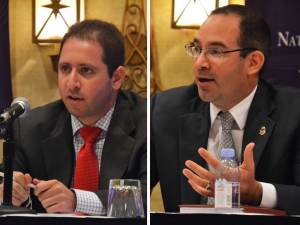
Transportation Security Administration (TSA) Press Secretary Ross Feinstein and U.S. Customs and Border Protection Media Division Director Michael Friel
WASHINGTON — U.S. Customs and Border Protection Media Division Director Michael Friel and Transportation Security Administration (TSA) Press Secretary Ross Feinstein recently challenged journalists to go beyond the obvious when covering their agencies.
The Oct. 2 panel discussion, entitled “Covering National Security in your Community,” was held as part of “Covering the Military, Veterans and Homeland Security: Tomorrow’s Trends and Issues,” the Medill National Security Journalism Initiative’s 2014 conference.
During the event, Friel said that people’s understandings of the CPB largely depend on where they come from because the agency has a wide variety of geographically dependent mission sets.
For instance, he said, people who grew up in border towns would probably have a greater familiarity with the U.S. Border Patrol, whereas those who grew up near big cities would more readily recognize Customs agents from transit hubs or points of entry, like airports or seaports.
But Friel urged the crowd to go beyond the familiar when searching for stories.
“As you know, there is a focus on our agency that I think is immigration-heavy so a lot of our work is with immigration-related reporters,” he said. “Of course, that is an important story and it gets a lot of attention. The agency is broad, though.”
Friel said that CPB is “an all-threats agency” dedicated to safeguarding Americans against any incoming risk, whether it be a rice shipment that contains an insect with the potential to threaten American agriculture, an individual attempting to cross a U.S. border with fake papers or a shipment of intellectualproperty-violating products coming into the U.S. via cargo ship.
Feinstein also acknowledged the existence of reporting trends for his agency.
“People think TSA just controls the airports,” Feinstein said, saying that local and tech angles understandably drew the most reporters to cover his agency’s work with security checkpoints.
“Well, it’s not true,” he said.
Feinstein distinguished that the TSA only handles airports’ “security screening apparatus,” and that it has no control over the airports themselves. Before or after security screenings, he explained, law enforcement is in charge.
Feinstein shared more unconventional storylines that he’s seen reporters explore in an attempt to broaden audiences’ interest.
The work of TSA intelligence officers, who collaborate with local airports to examine “any type of ways that we need to enhance aviation security,” and of Visible Intermodal Prevention and Response (VIPR) teams, which collaborate with mass transit organizations, were among the storylines he found to be the most compelling.
Above all, Feinstein stressed that the TSA’s relationships with officials and law enforcement on the local level are a huge part of the story of both the agency’s role in protecting America.
“It’s really important to see how that all comes together to make the nation’s security work,” he said.





